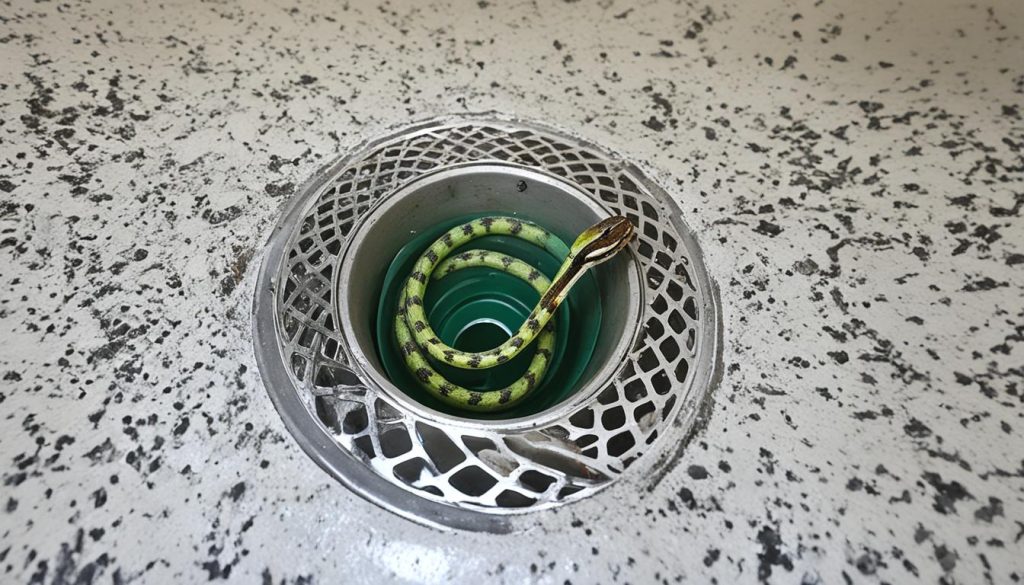Unclog Pipes Easily: How to Use Drain Snake
Did you know that clogged drains are a common problem in households across Canada? In fact, according to recent statistics, more than 60% of homeowners experience issues with slow-draining or blocked drains at some point. Fortunately, there is a simple and cost-effective solution: using a drain snake.
A drain snake, also known as a drain auger or plumbing snake, is a tool that can be easily used to clear clogs in your home’s pipes. Whether it’s a shower drain, bathtub drain, sink drain, or even a toilet, a drain snake can help you unclog the pipes without the need for a plumber.
Are you curious to learn more about how to use a drain snake and effectively clear those stubborn clogs? In this article, I’ll guide you through the process, providing step-by-step instructions and tips for success. So, grab your drain snake and let’s get started on tackling those drain blockages!
Key Takeaways:
- Unclogging drains with a drain snake is a cost-effective and convenient DIY solution.
- A drain snake can effectively clear common clogs like hair, food debris, grease, soap scum, and small objects.
- There are different types of drain snakes available, including manual cable snakes, power snakes, and toilet augers.
- To snake a shower or bathtub drain, remove the drain cover, insert the snake, hook onto the clog, and then test the drain.
- When snaking a toilet, use a toilet auger specifically designed for unclogging toilets, and check the end of the wire for any objects.
Benefits of Using a Drain Snake
Using a drain snake has several benefits. It is an accessible and affordable tool that can be easily found in hardware stores. A drain snake is simple to use, requiring little skill or experience. It is also effective in clearing many common types of clogs, such as hair, food debris, cooking grease, soap scum, and small objects.
Check out the table below for a comprehensive guide to using a drain snake:
| Step | Description |
|---|---|
| Step 1 | Put on protective gloves and safety glasses. |
| Step 2 | Insert the end of the drain snake into the clogged drain. |
| Step 3 | Rotate the handle clockwise to extend the snake into the pipe. |
| Step 4 | When you feel resistance, rotate the handle counterclockwise to retrieve the snake and the clog. |
| Step 5 | Run hot water to flush any remaining debris and ensure the drain is clear. |
Important Note:
While a drain snake is effective in clearing many types of clogs, it may not be able to grab certain materials or clear all types of blockages. Additionally, it is important to avoid using drain cleaners or chemicals before snaking the drain, as they can be dangerous when combined with the snake.
Types of Drain Snakes
When it comes to unclogging drains, there are different types of drain snakes available to tackle various blockages. Each type of drain snake is specifically designed to address different plumbing needs. Let’s explore the three main types:
1. Manual Cable Snake
The manual cable snake is the most basic and commonly used type of drain snake. It features a flexible coiled cable with a hook at the end. This snake is manually operated, allowing you to feed the cable into the drain and rotate it to catch and remove clogs. Manual cable snakes come in various lengths to accommodate different drain sizes.
2. Power Snake
For more stubborn clogs, a power snake, also known as an electric drain snake or a motorized drain snake, is an excellent choice. This type of drain snake is equipped with a motor that rotates the cable, making it easier to penetrate and break through tough clogs. Power snakes can be attached to power tool heads like drills, providing added convenience and power for dealing with challenging blockages.
3. Toilet Auger
When it comes to clearing toilet clogs, a specific type of drain snake called a toilet auger, or water closet auger, is recommended. Toilet augers are specifically designed to navigate the curved trap of a toilet without scratching the porcelain. With a long, flexible cable and a protective sleeve, toilet augers can easily reach and remove clogs that cause toilet backups.
It’s important to choose the right type of drain snake for the specific clog you’re dealing with. Whether it’s a manual cable snake, a power snake, or a toilet auger, having the right tool will make unclogging drains a much easier task.
| Type of Drain Snake | Features | Best Used For |
|---|---|---|
| Manual Cable Snake | Flexible coiled cable with a hook at the end | Soft clogs in drains |
| Power Snake | Motorized rotation for handling tough clogs | Severe blockages requiring more power |
| Toilet Auger | Long, flexible cable with a protective sleeve | Toilet clogs without scratching the porcelain |
How to Snake a Shower or Bathtub Drain
Snaking a shower or bathtub drain can help clear clogs and restore proper drainage. Here’s a step-by-step guide on how to do it:
- Remove the drain cover or overflow plate: Start by locating the drain cover or overflow plate in your shower or bathtub. Depending on the design, you may need to unscrew it or simply lift it off.
- Prepare the snake: Obtain a drain snake suitable for your drain type. Ensure the snake cable is straightened out and extend it fully.
- Insert the snake: Carefully insert the snake cable into the drain, feeding it about two or three feet into the pipe.
- Hook onto the clog: Once the snake is inserted, turn the handle clockwise to rotate the snake and allow the hook at the end to grip onto the clog.
- Pull it back up: Slowly retract the snake by turning the handle counterclockwise, bringing the clog back up and out of the drain.
- Check for clearance: After removing the clog, run water down the drain to ensure it is flowing freely.
- Replace the cover or plate: Once you’ve verified that the drain is clear, reattach the drain cover or overflow plate using the appropriate method.
Snaking a shower or bathtub drain can be an effective way to clear clogs and restore proper drainage. By following these steps, you can maintain a clean and functioning drain system in your bathroom.
How to Snake a Toilet
Before trying more advanced methods, such as snaking a toilet, always attempt to unclog it using a plunger. If the plunger fails to clear the blockage, you can use a toilet auger designed specifically for this purpose.
To snake a toilet, follow these steps:
- Insert the toilet auger cable into the drain, starting with the curved end.
- Crank the auger to clear the blockage, ensuring to apply gentle pressure and avoid excessive force.
- Slowly pull the coiled wire out of the toilet, keeping a firm grip on the handle.
- Check the end of the wire for any objects or debris that may have caused the clog.
- With the blockage removed, flush the toilet to test if the issue has been resolved.
Remember to clean the toilet auger thoroughly after use to prevent any lingering residue or bacteria buildup.
How to Snake a Sink Drain
When it comes to clearing a clogged sink drain, you have two options: going through the drain directly or removing the P-trap. Both methods can effectively remove the blockage using a manual cable snake.
Snaking through the Drain
If you choose to go through the drain, start by inserting the auger head into the opening of the drain pipe. Push the coiled wire carefully into the pipe, ensuring it goes as far as possible. Once inserted, begin cranking the auger while applying gentle pressure to guide the cable further into the pipe. This motion helps the snake grab and dislodge the clog within the drain pipe. Once you feel some resistance or notice the clog breaking loose, start pulling the snake back slowly. Make sure to keep a firm grip on the auger handle to avoid any mishaps.
As you retract the cable, it will bring the dislodged debris with it, effectively clearing the clog from the sink drain. Repeat the process a few times if needed, running water to check if the drain is flowing freely again.
Removing the P-trap
If you prefer to remove the P-trap for easier access, begin by locating the slip-nut joints on the trap. Use tongue-and-groove pliers to gently loosen the nuts, allowing you to disconnect the P-trap from the sink drain. Place a bucket or a towel underneath the trap to catch any water or debris that may spill out.
Once the P-trap is removed, insert the manual cable snake into the pipe leading from the sink drain to the wall. Push the snake through the pipe, ensuring it reaches the clog. Rotate the snake as you feed it to help it grip onto the blockage. Slowly pull the snake back to remove the clog from the pipe.
After successfully clearing the clog, reassemble the P-trap by connecting the slip-nut joints tightly. Run water through the sink to ensure proper drainage.
Snaking a sink drain using a manual cable snake is an effective and cost-efficient method to clear stubborn clogs. With a little patience and the right technique, you can restore proper drainage to your sink without the need for professional assistance.
Tips and Considerations for Using a Drain Snake
When using a drain snake, it is important to prioritize your safety. Wear safety glasses and gloves to protect yourself from any potential debris or splashes. Safety should always come first!
Avoid using caustic chemicals or drain cleaners before snaking the drain, as they can be hazardous and cause chemical reactions when combined with the snake. Stick to the snake alone for a safe and effective solution.
Remember to pull the cable straight out of the drain to prevent the obstruction from re-depositing in the pipes. This will ensure that you are fully removing the clog instead of just pushing it further down the line.
If you find that the snake gets stuck during the process, don’t panic. Simply turn the drum and cable in reverse while slowly backing it out of the drain. This technique helps release any caught debris and allows you to continue with the clearing process.
After successfully unclogging the drain, it is always a good practice to wash off the drain snake. This helps prevent bacteria buildup and ensures a clean tool for future use. A quick rinse with warm water and mild soap will do the trick.
However, if the clog is persistent and beyond the reach of the drain snake or if you have made repeated attempts without success, it is advisable to call a professional plumber. They have the expertise and specialized tools to handle more complex plumbing issues.
- Investing Wisely: How Windows & Doors in Boost Property Value and Financial Health - April 24, 2025
- The Financial Impact of Personal Injuries: Why Legal Help Matters for Business Owners - April 16, 2025
- The Hidden Financial Costs of Domestic Assault: What Business Owners Need to Know - April 16, 2025














